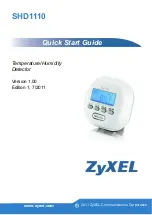
– 186 –
7
Flow Sampling Commands
Flow sampling (sFlow) can be used with a remote sFlow Collector to provide
an accurate, detailed and real-time overview of the types and levels of traffic
present on the network. The sFlow Agent samples 1 out of
n
packets from all
data traversing the switch, re-encapsulates the samples as sFlow datagrams
and transmits them to the sFlow Collector. This sampling occurs at the internal
hardware level where all traffic is seen, whereas traditional probes only have a
partial view of traffic as it is sampled at the monitored interface. Moreover, the
processor and memory load imposed by the sFlow agent is minimal since
local analysis does not take place.
Note:
The terms “collector”, “receiver” and “owner”, in the context of this
chapter, all refer to a remote server capable of receiving the sFlow datagrams
generated by the sFlow agent of the switch.
sflow owner
This command creates an sFlow collector on the switch. Use the
no
form to
remove the sFlow receiver.
Syntax
sflow
owner
owner-name
timeout
timeout-value
[
destination
{
ipv4-address | ipv6-address
}] [
port
destination-udp-
port
] [
max-datagram-size
max-datagram-size
] [
version
{
v4
|
v5
}]
no sflow owner
owner-name
owner-name -
Name of the collector. (Range: 1-30 alphanumeric
characters)
timeout-value
- The length of time the sFlow interface is available to
send samples to a receiver, after which the owner and associated
Table 33: sFlow Commands
Command
Function
Mode
Creates an sFlow collector which the switch uses to
send samples to.
PE
Configures an sFlow polling data source that takes
samples periodically based on time.
PE
Configures an sFlow sampling data source that
samples periodically based on a packet count.
PE
Shows the global and interface settings for the sFlow
process
PE
















































